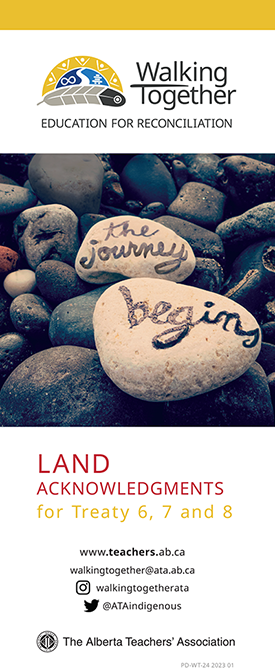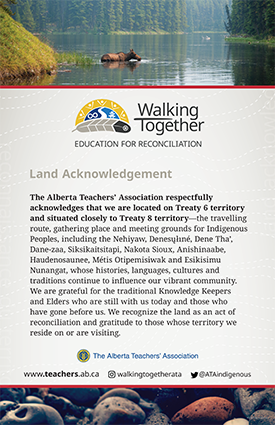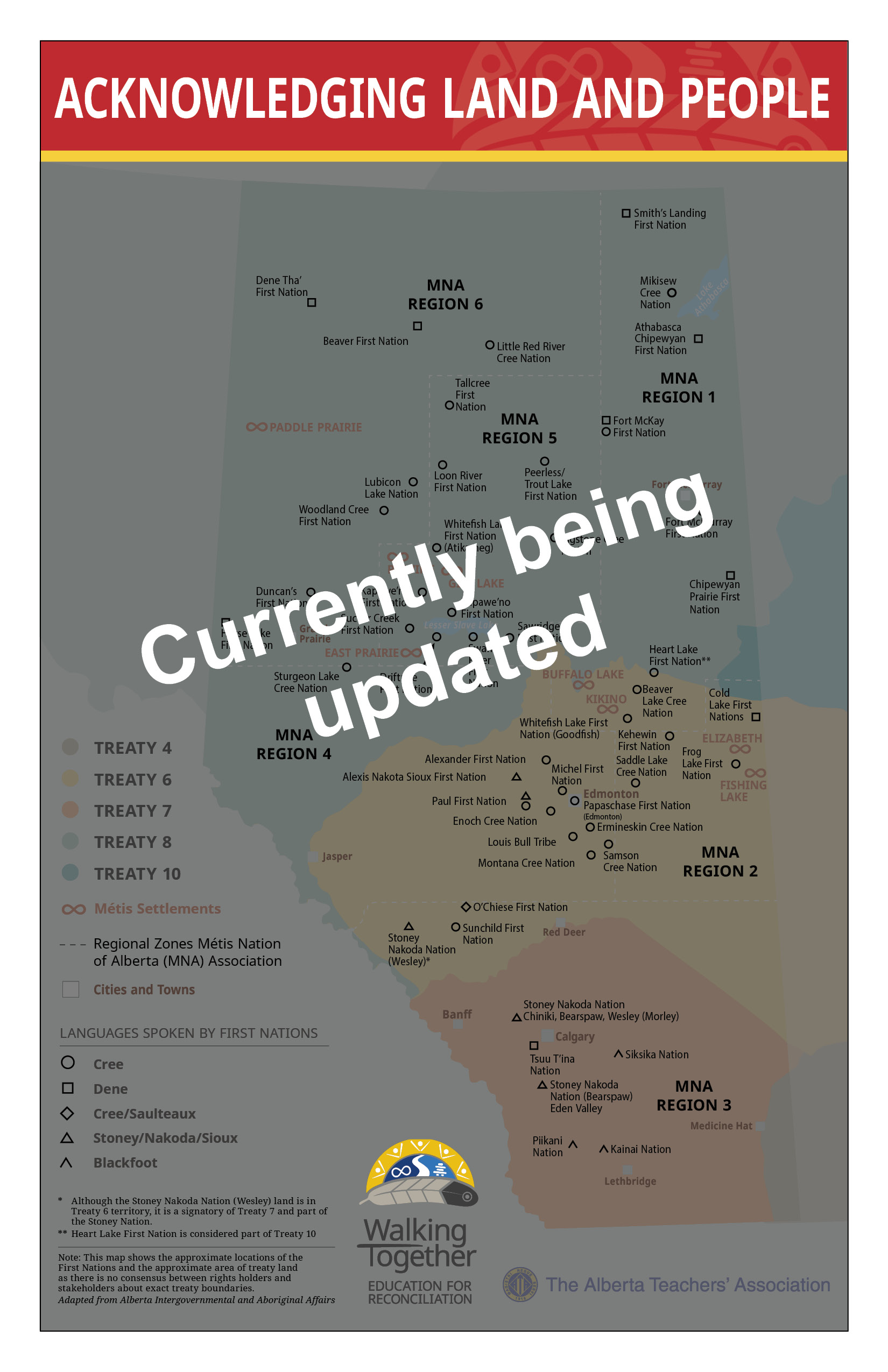Acknowledging the land where we gather
Land acknowledgements should be part of a thoughtful, intentional process that moves beyond performative gestures of reconciliation. They are entry points in the journey of truth and reconciliation, and they are meaningful if partnered with ongoing education and action. When sharing a land acknowledgement, consider reflecting on your own relationships and connections to Indigenous people, languages, cultures, stories, and traditions from the land you are residing on or visiting.
When sharing land acknowledgements:
- The land acknowledgement should be provided by the host as part of the meeting introduction or the daily opening event (before the national anthem).
- Local Indigenous dignitaries can be invited to provide a welcome to the territory. Indigenous people who are attending the meeting or event should not be expected to share land acknowledgements unless previously arranged.
- Select the acknowledgement based on the location of your event. The general land acknowledgement can be used for large provincial or virtual events, or you can combine multiple acknowledgements when situated closely to multiple treaty areas or boundaries, such as Athabasca, Red Deer or Medicine Hat.
Treaty land acknowledgements
Treaty specific land acknowledgement videos and text identifying the names of regional Indigenous places, communities, and nations
Treaty 6 / Traité n° 6
English
The Alberta Teachers’ Association respectfully acknowledges that we are located on Treaty 6 territory—the travelling route, gathering place and meeting grounds for Indigenous Peoples, including the Nehiyaw, Denesųłıné, Siksikaitsitapi, Nakota Sioux, Anishinaabe, Haudenosaunee, Métis Otipemisiwak and Esikisimu Nunangat, whose histories, languages, cultures and traditions continue to influence our vibrant community. We are grateful for the traditional Knowledge Keepers and Elders who are still with us today and those who have gone before us. We recognize the land as an act of reconciliation and gratitude to those whose territory we reside on or are visiting.
French
L’Alberta Teachers’ Association reconnait respectueusement que nous nous trouvons sur le territoire visé par le Traité no 6, un lieu de rassemblement et de rencontre ainsi qu’un corridor où se déplacent des peuples autochtones, y compris les Nehiyaw, les Denesųłınés, les Siksikaitsitapi, les Sioux Nakotas, les Anishinaabe, les Haudenosaunee, les Métis Otipemisiwak et les Esikisimu Nunangat, dont les histoires, les langues, les cultures et les traditions continuent d’influencer notre communauté dynamique. Nous sommes reconnaissants envers les gardiens du savoir traditionnel et les Ainés, ceux qui sont toujours parmi nous comme ceux qui nous ont précédés. Nous reconnaissons ces terres en guise d’acte de réconciliation et pour exprimer notre gratitude envers ceux dont le territoire est l’endroit où nous résidons ou que nous visitons.
Treaty 7 / Traité n° 7
English
The Alberta Teachers’ Association respectfully acknowledges that we are located on Treaty 7 territory—the travelling route, gathering place and meeting grounds for Indigenous Peoples, including the Siksikaitsitapi, comprised of the Siksika, Kainai, Piikani, Amskapi Piikani First Nations; the Tsuut’ina First Nation; and the Îyârhe Nakoda, including the Chiniki, Bearspaw and Goodstoney First Nations, Métis Otipemisiwak and Esikisimu Nunangat, whose histories, languages, cultures and traditions continue to influence our vibrant community. We are grateful for the traditional Knowledge Keepers and Elders who are still with us today and those who have gone before us. We recognize the land as an act of reconciliation and gratitude to those whose territory we reside on or are visiting.
French
L’Alberta Teachers’ Association reconnait respectueusement que nous nous trouvons sur le territoire visé par le Traité no 7, un lieu de rassemblement et de rencontre ainsi qu’un corridor où se déplacent des peuples autochtones, y compris les Siksikaitsitapi, peuple composé des Premières Nations Siksika, Kainai, Piikani, Amskapi Piikani; la Première Nation Tsuut’ina; et les Nakodas Îyârhes, y compris les Premières Nations Chiniki, Bearspaw et Goodstoney, les Métis Otipemisiwak et les Esikisimu Nunangat, dont les histoires, les langues, les cultures et les traditions continuent d’influencer notre communauté dynamique. Nous sommes reconnaissants envers les gardiens du savoir traditionnel et les Ainés, ceux qui sont toujours parmi nous comme ceux qui nous ont précédés. Nous reconnaissons ces terres en guise d’acte de réconciliation et pour exprimer notre gratitude envers ceux dont le territoire est l’endroit où nous résidons ou que nous visitons.
Treaty 8 / Traité n° 8
English
The Alberta Teachers’ Association respectfully acknowledges that we are located on Treaty 8 territory—the travelling route, gathering place and meeting grounds for Indigenous Peoples, including the Nehiyaw, Denesųłıné, Dene Tha', Dane-zaa, Métis Otipemisiwak and Esikisimu Nunangat, whose histories, languages, cultures and traditions continue to influence our vibrant community. We are grateful for the traditional Knowledge Keepers and Elders who are still with us today and those who have gone before us. We recognize the land as an act of reconciliation and gratitude to those whose territory we reside on or are visiting.
French
L’Alberta Teachers’ Association reconnait respectueusement que nous nous trouvons sur le territoire visé par le Traité no 8, un lieu de rassemblement et de rencontre ainsi qu’un corridor où se déplacent des peuples autochtones, y compris les Nehiyaw, les Denesųłınés, les Dene Tha’, les Dane-zaa, les Métis Otipemisiwak et les Esikisimu Nunangat, dont les histoires, les langues, les cultures et les traditions continuent d’influencer notre communauté dynamique. Nous sommes reconnaissants envers les gardiens du savoir traditionnel et les Ainés, ceux qui sont toujours parmi nous comme ceux qui nous ont précédés. Nous reconnaissons ces terres en guise d’acte de réconciliation et pour exprimer notre gratitude envers ceux dont le territoire est l’endroit où nous résidons ou que nous visitons.
General Land Acknowledgement (used for large or virtual events) / Reconnaissance du territoire générale
English
The Alberta Teachers’ Association respectfully acknowledges that we are located on Treaty 4, 6, 7, 8 and 10 territories—the travelling route, gathering place and meeting grounds for Indigenous Peoples, including the Siksikaitsitapi, comprised of the Siksika, Kainai, Piikani, Amskapi Piikani First Nations; the Tsuut’ina First Nation; and the Îyârhe Nakoda, including the Chiniki, Bearspaw and Goodstoney First Nations; and the Nehiyaw, Denesųłıné, Dene Tha', Dane-zaa, Nakota Sioux, Anishinaabe, Haudenosaunee, Métis Otipemisiwak and Esikisimu Nunangat, whose histories, languages, cultures and traditions continue to influence our vibrant community. We are grateful for the traditional Knowledge Keepers and Elders who are still with us today and those who have gone before us. We recognize the land as an act of reconciliation and gratitude to those whose territory we reside on or are visiting.
French
L’Alberta Teachers’ Association reconnait respectueusement que nous nous trouvons sur les territoires visés par les Traités nos 4, 6, 7, 8 et 10, un lieu de rassemblement et de rencontre ainsi qu’un corridor où se déplacent des peuples autochtones, y compris les Siksikaitsitapi, peuple composé des Premières Nations Siksika, Kainai, Piikani, Amskapi Piikani; la Première Nation Tsuut’ina; et les Nakodas Îyârhes, y compris les Premières Nations Chiniki, Bearspaw et Goodstoney; et les Nehiyaw, les Denesųłınés, les Dene Tha’, les Dane-zaa, les Sioux Nakotas, les Anishinaabe, les Haudenosaunee, les Métis Otipemisiwak et les Esikisimu Nunangat, dont les histoires, les langues, les cultures et les traditions continuent d’influencer notre communauté dynamique. Nous sommes reconnaissants envers les gardiens du savoir traditionnel et les Ainés, ceux qui sont toujours parmi nous comme ceux qui nous ont précédés. Nous reconnaissons ces terres en guise d’acte de réconciliation et pour exprimer notre gratitude envers ceux dont le territoire est l’endroit où nous résidons ou que nous visitons.
General Land Acknowledgement (short)
The Alberta Teachers’ Association respectfully acknowledges that we are located on Treaty 4, 6, 7, 8 and 10 territories—the travelling route, gathering place and meeting grounds for Indigenous Peoples, whose histories, languages, cultures and traditions continue to influence our vibrant community. We are grateful for the traditional Knowledge Keepers and Elders who are still with us today and those who have gone before us. We recognize the land as an act of reconciliation and gratitude to those whose territory we reside on or are visiting.
L’Alberta Teachers’ Association reconnait respectueusement que nous nous trouvons sur les territoires visés par les Traités nos 4, 6, 7, 8 et 10, un lieu de rassemblement et de rencontre ainsi qu’un corridor où se déplacent des peuples autochtones, dont les histoires, les langues, les cultures et les traditions continuent d’influencer notre communauté dynamique. Nous sommes reconnaissants envers les gardiens du savoir traditionnel et les Ainés, ceux qui sont toujours parmi nous comme ceux qui nous ont précédés. Nous reconnaissons ces terres en guise d’acte de réconciliation et pour exprimer notre gratitude envers ceux dont le territoire est l’endroit où nous résidons ou que nous visitons.
Combining land acknowledgements for multiple treaty areas
The following are suggested text, guidelines and video presentation for acknowledging land and Peoples near multiple treaty boundaries
Sample
English
The Alberta Teachers’ Association respectfully acknowledges that we are located on Treaty [include treaty number] territory and situated closely to Treaty [include treaty number] territory—the travelling route, gathering place and meeting grounds for Indigenous Peoples, including the [insert all nations within the acknowledged treaty areas], Métis Otipemisiwak and Esikisimu Nunangat, whose histories, languages, cultures and traditions continue to influence our vibrant community. We are grateful for the traditional Knowledge Keepers and Elders who are still with us today and those who have gone before us. We recognize the land as an act of reconciliation and gratitude to those whose territory we reside on or are visiting.
French
L’Alberta Teachers’ Association reconnait respectueusement que nous nous trouvons sur le territoire visé par le Traité [insérer le numéro du traité] et près du territoire visé par le Traité [insérer le numéro du traité], un lieu de rassemblement et de rencontre ainsi qu’un corridor où se déplacent des peuples autochtones, y compris les [insérer le nom de toutes les nations présentes dans les régions visées par les traités en question], les Métis Otipemisiwak et les Esikisimu Nunangat, dont les histoires, les langues, les cultures et les traditions continuent d’influencer notre communauté dynamique. Nous sommes reconnaissants envers les gardiens du savoir traditionnel et les Ainés, ceux qui sont toujours parmi nous comme ceux qui nous ont précédés. Nous reconnaissons ces terres en guise d’acte de réconciliation et pour exprimer notre gratitude envers ceux dont le territoire est l’endroit où nous résidons ou que nous visitons.
Treaty 6 and 8 / Traité n° 6 et n° 8
English
The Alberta Teachers’ Association respectfully acknowledges that we are located on Treaty 6 territory and situated closely to Treaty 8 territory—the travelling route, gathering place and meeting grounds for Indigenous Peoples, including the Nehiyaw, Denesųłıné, Dene-Tha, Dane-Zaa, Siksikaitsitapi, Nakota Sioux, Anishinaabe, Haudenosaunee, Métis Otipemisiwak and Esikisimu Nunangat, whose histories, languages, cultures and traditions continue to influence our vibrant community. We are grateful for the traditional Knowledge Keepers and Elders who are still with us today and those who have gone before us. We recognize the land as an act of reconciliation and gratitude to those whose territory we reside on or are visiting.
French
L’Alberta Teachers’ Association reconnait respectueusement que nous nous trouvons sur le territoire visé par le Traité no 6 et près du territoire visé par le Traité no 8, un lieu de rassemblement et de rencontre ainsi qu’un corridor où se déplacent des peuples autochtones, y compris les Nehiyaw, les Denesųłınés, les Dene Tha’, les Dane-zaa, les Siksikaitsitapi, les Sioux Nakotas, les Anishinaabe, les Haudenosaunee, les Métis Otipemisiwak et les Esikisimu Nunangat, dont les histoires, les langues, les cultures et les traditions continuent d’influencer notre communauté dynamique. Nous sommes reconnaissants envers les gardiens du savoir traditionnel et les Ainés, ceux qui sont toujours parmi nous comme ceux qui nous ont précédés. Nous reconnaissons ces terres en guise d’acte de réconciliation et pour exprimer notre gratitude envers ceux dont le territoire est l’endroit où nous résidons ou que nous visitons.
Treaty 4 and 7 / Traité n° 4 et n° 7
English
The Alberta Teachers’ Association respectfully acknowledges that we are located on Treaty 7 territory and situated closely to Treaty 4 territory—the travelling route, gathering place and meeting grounds for Indigenous Peoples, including the Siksikaitsitapi, comprised of the Siksika, Kainai, Piikani, Amskapi Piikani First Nations; the Tsuut’ina First Nation; and the Îyârhe Nakoda, including the Chiniki, Bearspaw and Goodstoney First Nations; and Nehiyaw, Anishinaabe, Nakota, Lakota, Dakota, Métis Otipemisiwak and Esikisimu Nunangat, whose histories, languages, cultures and traditions continue to influence our vibrant community. We are grateful for the traditional Knowledge Keepers and Elders who are still with us today and those who have gone before us. We recognize the land as an act of reconciliation and gratitude to those whose territory we reside on or are visiting.
French
L’Alberta Teachers’ Association reconnait respectueusement que nous nous trouvons sur le territoire visé par le Traité no 7 et près du territoire visé par le Traité no 4, un lieu de rassemblement et de rencontre ainsi qu’un corridor où se déplacent des peuples autochtones, y compris les Siksikaitsitapi, peuple composé des Premières Nations Siksika, Kainai, Piikani, Amskapi Piikani; la Première Nation Tsuut’ina; et les Nakodas Îyârhes, y compris les Premières Nations Chiniki, Bearspaw et Goodstoney; et les Nehiyaw, les Anishinaabe, les Nakotas, les Lakotas, les Dakotas, les Métis Otipemisiwak et les Esikisimu Nunangat, dont les histoires, les langues, les cultures et les traditions continuent d’influencer notre communauté dynamique. Nous sommes reconnaissants envers les gardiens du savoir traditionnel et les Ainés, ceux qui sont toujours parmi nous comme ceux qui nous ont précédés. Nous reconnaissons ces terres en guise d’acte de réconciliation et pour exprimer notre gratitude envers ceux dont le territoire est l’endroit où nous résidons ou que nous visitons.
Treaty 6 and 7 / Traité n° 6 et n° 7
English
The Alberta Teachers’ Association respectfully acknowledges that we are located on Treaty 6 territory and situated closely to Treaty 7 territory—the travelling route, gathering place and meeting grounds for Indigenous Peoples, including the Nehiyaw, Denesųłıné, Nakota Sioux, Anishinaabe, Haudenosaunee, Siksikaitsitapi, comprised of the Siksika, Kainai, Piikani, Amskapi Piikani First Nations; the Tsuut’ina First Nation; and the Îyârhe Nakoda, including the Chiniki, Bearspaw and Goodstoney First Nations, Métis Otipemisiwak and Esikisimu Nunangat, whose histories, languages, cultures and traditions continue to influence our vibrant community. We are grateful for the traditional Knowledge Keepers and Elders who are still with us today and those who have gone before us. We recognize the land as an act of reconciliation and gratitude to those whose territory we reside on or are visiting.
French
L’Alberta Teachers’ Association reconnait respectueusement que nous nous trouvons sur le territoire visé par le Traité no 6 et près du territoire visé par le Traité no 7, un lieu de rassemblement et de rencontre ainsi qu’un corridor où se déplacent des peuples autochtones, y compris les Nehiyaw, les Denesųłınés, les Sioux Nakotas, les Anishinaabe, les Haudenosaunee, les Siksikaitsitapi, peuple composé des Premières Nations Siksika, Kainai, Piikani, Amskapi Piikani; la Première Nation Tsuut’ina; et les Nakodas Îyârhes, y compris les Premières Nations Chiniki, Bearspaw et Goodstoney, les Métis Otipemisiwak et les Esikisimu Nunangat, dont les histoires, les langues, les cultures et les traditions continuent d’influencer notre communauté dynamique. Nous sommes reconnaissants envers les gardiens du savoir traditionnel et les Ainés, ceux qui sont toujours parmi nous comme ceux qui nous ont précédés. Nous reconnaissons ces terres en guise d’acte de réconciliation et pour exprimer notre gratitude envers ceux dont le territoire est l’endroit où nous résidons ou que nous visitons.
Pronunciation Guide
Learning how to pronounce the names of Indigenous places, communities and nations is a respectful way to support and learn Indigenous languages. Pronunciations within an Indigenous language will vary from community to community, family to family, and individual to individual. There are different ways to pronounce based on regions and dialects. The following pronunciations have been generously provided by Elders and Knowledge Keepers from the Indigenous Advisory Circle within the Alberta Teachers’ Association.
Land acknowledgements with embedded pronunciation
Déclarations de reconnaissance des territoires avec la prononciation du nom des peuples
| English | French | ||
|---|---|---|---|
| Name | English pronunciation | Name | French pronunciation |
| Amskapi Piikani | Ahm-skah-pee Pee-gun-nee | Amskapi Piikani | Âm-skâ-pi Pi-gâ-ni |
| Anishinaabe | Ah-nish-nah-bey | Anishinaabe | Â-niche-nâ-bé |
| Bearspaw | Bears-paw | Bearspaw | Bèrz-pâ |
| Chiniki | Chin-ih-kee | Chiniki | Tchin-i-ki |
| Denesųłıné | De-ne-soo-leh-nay | Denesųłıné | Dé-né-sou-li-né |
| Dene Tha' | De-ne-tha | Dene Tha’ | Dé-né-ta |
| Dane-zaa | De-ne-za | Dane-zaa | Dé-né-za |
| Esikisimu Nunangat | Ee-see-kee-see-mu Nu-na-nat | Esikisimu Nunangat | I-si-ki-si-mou Nou-na-nat |
| Goodstoney | Good-stone-ee | Goodstoney | Goude-stô-ni |
| Haudenosaunee | Hoh-de-noh-shoh-nee | Haudenosaunee | Ô-dé-nô-châ-ni |
| Îyârhe Nakoda | Ae-yar-hay Na-koh-da | Nakoda Îyârhe | Na-kô-da È-iar-hé |
| Kainai | Gay-nah | Kainai | Gué-na |
| Métis Otipemisiwak | May-tee Oh-tih-pem-soo-wuk | Métis Otipemisiwak | Mé-ti Ô-ti-pèm-sou-ouk |
| Nakota Sioux | Na-koh-da Soo | Sioux Nakota | Sou Na-kô-da |
| Nehiyaw | Ne-hee-yo | Nehiyaw | Nè-hi-iô |
| Piikani | Pee-gun-ee | Piikani | Pi-gâ-ni |
| Siksikaitsitapi | Sik-sik-aye-sit-a-pee | Siksikaitsitapi | Sic-sic-aille-si-ta-pi |
| Siksika | Sik-sik-a | Siksika | Sic-sic-ka |
| Tsuut’ina | Soot-inna | Tsuut’ina | Soute-ina |
Bookmark

| Land acknowledgements bookmarks
|
Posters

| General poster English/French combined, 11x17" |

| Single Treaty posters English/French combined, 11x17"
|

| Combined Treaty posters English/French combined, 11x17" |
Acknowledging land and people map

|
|